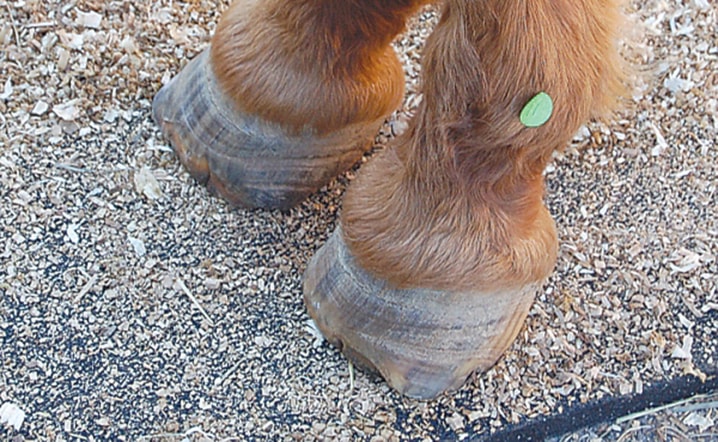Laminitis Part 1
Laminitis is a potentially life-threatening disease that all horses are at risk of developing.
There are a variety of risk factors and conditions that may predispose one particular horse versus another, but no horse is immune regardless of how well managed they are.
What is laminitis? Simply said, it’s an inflammation of the lamina of the foot. Within the hoof wall there is a triangular shaped coffin bone that matches in orientation to the shape of the hoof. It is literally suspended above the cushioning structures of the foot by a Velcro-like structure called lamina.
This lamina has interlocking fingers both on the interior of the hoof wall and the exterior of the coffin bone that hold it in place.
During an attack of laminitis, an enzymatic reaction causes the lamina to swell.
The inflammation in the foot decreases the blood flow to the internal structures of the hoof and this decrease in available nutrition leads to cell damage and death. If left untreated, the Velcro like property of the lamina weakens, allowing the coffin bone to begin rotating down, potentially until it penetrates the hoof wall.
During an attack of laminitis the horse’s foot feels warm to the touch and the distal pulse (found at the back of the pastern) is increased. The horse will be reluctant to move and he may frequently shift his weight around. When he does move, he may appear sounder on a straight line and sorer when asked to turn. In attempt to relieve the pain, he will often stand rocked back onto his heels, to decrease the pressure on the toe.
It’s important to remember that the hoof wall is a solid structure with minimal room for expansion with the significant amount of swelling that is occurring. This swelling needs to be reduced to minimize the damage to the internal structures. Laminitis is not something that even an experienced horse person should be treating without the consultation of a veterinarian. If you see symptoms of this condition you should call your veterinarian immediately. Working with your veterinarian and an experienced farrier can help keep your horse as comfortable as possible.
Sometimes the term laminitis is used interchangeably with the term founder. In my experience, founder is used to describe the more chronic laminitis where the coffin bone has rotated. I don’t think there’s a right or wrong way of using the term but that’s how I’ve always heard it used.
There are three types of laminitis based of the cause of the condition. Each classification encompasses a variety of similar mechanisms. I will outline each type, the causes involved and what can be done to treat and possibly prevent each type.
Enzyme Activated — These versions of laminitis encompass the more commonly associated causes of the condition. The stereotypical pony getting too much green grass in the spring is a common scenario this time of year. The loose horse getting into the feed room and eating half a bag of sweet is also a common triggering event. Both include an abnormally high intake of carbohydrates in a relatively short period of time. Anything that contributes to gastrointestinal upset or causes diarrhea can lead to laminitis.
Contact with black walnut shavings can cause laminitis. Although this product is not sold for horses, horse owners need to be aware of the risk to prevent accidental exposure.
Mares need to be monitored carefully after foaling for any signs of retained placenta, as this can also trigger a case of laminitis. If you have notice the absence of a complete placenta post foaling or any other indications that your mare has not ‘cleaned’ thoroughly you should contact your veterinarian immediately. Laminitis can occur as a secondary condition to many serious problems. Horses that have suffered from colic, whether they received surgery or not, should be carefully monitored for signs of laminitis. Potomac Horse Fever is another condition to carefully monitor for this reason.
If a potential triggering event (such as getting into the feed room) is identified very early, there are methods your veterinarian can use to prevent the condition progressing. The use of ice therapy has shown exciting results in stopping the progression of the condition, the earlier the detection the better chance to minimize damage.
To be continued next time when I will continue to discuss the other types of laminitis, until next time be aware of the laminitis risks in your horse’s environment.
Shelly L. Graham is a local rider, trainer, horse breeder and Equine Canada certified coach.
